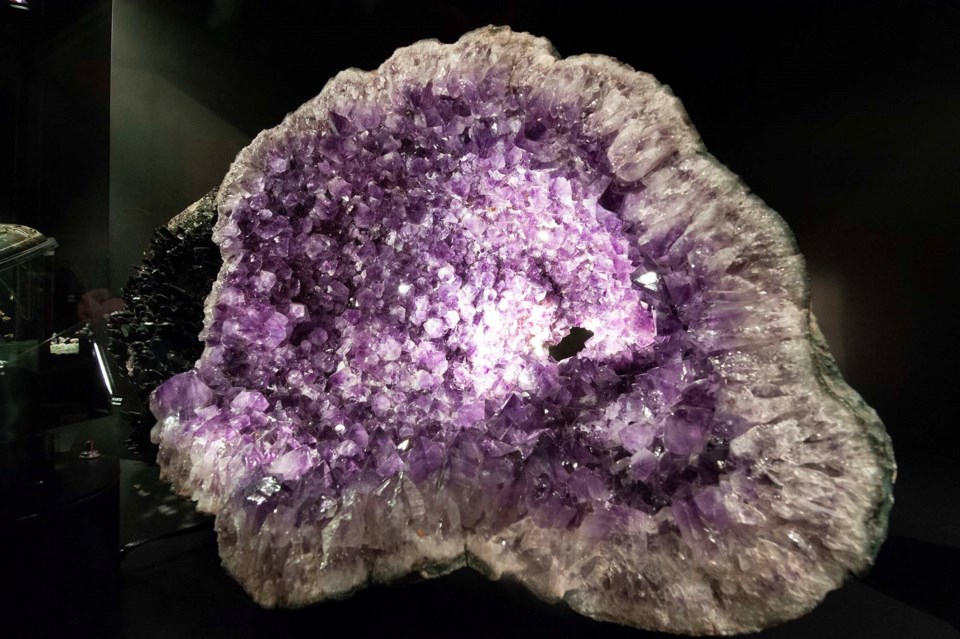Scientific St. Albert
The Gazette is using science to answer questions from students of all ages about the world around them. Send in your questions to [email protected].
Geodes are neato. Dull and drab without, but sparkling and rainbow-hued within, these spectacular stones are excellent examples of the natural wonders beneath our feet.
Four Winds Public Grade 6 student Alys Buzila seems to be a fan of geodes, as she asked Scientific St. Albert, “I wonder how geodes would be able to form if we were still in an ice age?”
Geode primer
A geode is a hollow rock with crystallized minerals on its insides, said Tom Chacko, curator of the mineralogy museum at the University of Alberta. Most are spherical or oblate, and contain crystals which become evident when you crack them open.
All minerals are crystals, but most crystals are very small as they don’t have space to grow, said Paula Piilonen, mineralogist at the Canadian Museum of Nature. If a rock has a big open space in it — typically the result of a gas bubble — that space can fill with hot water supersaturated with dissolved minerals. As that water cools, it loses space for its minerals, which precipitate out in the form of crystals.
The crystals in geodes have many names and colours but are all basically different types of quartz (a three-sided oxygen-silicon crystal that is Earth’s most common mineral), Piilonen said. Purple quartz contains iron and is called amethyst. Pink quartz contains titanium oxide, while smoky quartz has turned yellow, brown or black due to radiation. Multicoloured layers of quartz are called agate. If there’s lots of water in your quartz, it may become rainbow-hued opal.
It's hot down there
On the one hand, it kind of make sense to think about geodes and ice ages. After all, if geodes rely on liquid water, and ice ages freeze water, wouldn’t the latter prevent the former from happening?
Not really, said Chacko.
“Geodes always form at least some distance under the surface of the planet,” he said.
“Even if the surface is frozen, if you go below the permafrost layer, it’s going to be unfrozen.”
Due to a combination of pressure, trapped heat from the planet’s formation, and radioactive elements, the Earth’s interior is hot, and gets hotter the deeper underground you go, Chacko said. This means you can always find mineral-rich liquids sloshing around underground, and if those liquids find an open space, they can pool, cool, and start forming geodes.
“Undoubtedly, geodes are being formed right now someplace,” Chacko said.
Geodes can take thousands or millions of years to form, which is much longer than an ice age, Chacko and Piilonen said. Ice ages also don’t cover all of Earth at once, and don’t stop geode-making volcanoes from erupting.
Ice ages can affect the crystals in geodes through temperature fluctuations, said Joan Manuel García-Ruiz, a professor of minerology at the University of Granada in Spain.
His research on the world’s biggest geode, the Geode of Pulpí, suggests that it formed over thousands of years during the Pleistocene ice age, a period during which glaciers repeatedly advanced and retreated across the Earth’s surface as the planet swung between warm and cold. Warm temperatures let water in the geode dissolve tiny crystals, while cold ones caused more minerals to precipitate out onto big crystals — a process called Ostwald ripening, which is the process that gives old ice cream its gritty texture. Eventually, this process resulted in the ice-like two-meter-long gypsum crystals found in the geode. García-Ruiz said similar temperature fluctuations may explain the nearly 12 m long crystals in the Cave of Crystals in Naica.
Chacko said geodes can give researchers clues about how fluids flow underground and how valuable mineral deposits form.
Geodes might not have to do much with ice ages, but they certainly look cool.



